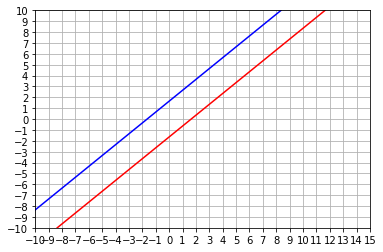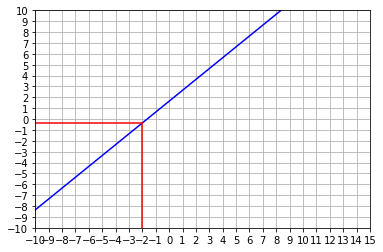Gaussian Confidence Intervals#
import numpy as np
from scipy.stats import norm
import matplotlib.pyplot as plt
%matplotlib inline
# Resolution
sigma_thetahat = 1.0
confidenceinterval = 0.9
prob_left = (1.-0.9)/2.
prob_right = (1.-0.9)/2.
theta_min = -10.0
theta_max = 10.0
theta_obsmin = -5.0
theta_obsmax = 5.0
thetas = [] # array to collect the scanned theta
lbounds = [] # array to collect the left bounds
rbounds = [] # array to collect the right bounds
nsteps = 100
for i in range(nsteps+1):
theta = theta_min + i/nsteps*(theta_max-theta_min)
left_bound = norm.ppf(prob_left, loc=theta, scale=sigma_thetahat)
right_bound = norm.ppf(1-prob_right, loc=theta, scale=sigma_thetahat)
# print (theta, left_bound, right_bound)
thetas.append(theta)
lbounds.append(left_bound)
rbounds.append(right_bound)
plt.plot(lbounds,thetas, 'b-')
plt.plot(rbounds,thetas, 'r-')
plt.axis([-10,15,-8,8])
plt.xticks(np.arange(-10,16, 1.0))
plt.yticks(np.arange(-10,11, 1.0))
plt.grid()
plt.show()

Upper limit at 95%#
import numpy as np
from scipy.stats import norm
import matplotlib.pyplot as plt
%matplotlib inline
# Resolution
sigma_thetahat = 1.0
confidenceinterval = 0.95
prob_left = 1 - confidenceinterval
theta_min = -10.0
theta_max = 10.0
theta_obsmin = -5.0
theta_obsmax = 5.0
thetas = [] # array to collect the scanned theta
lbounds = [] # array to collect the left bounds
nsteps = 100
for i in range(nsteps+1):
theta = theta_min + i/nsteps*(theta_max-theta_min)
left_bound = norm.ppf(prob_left, loc=theta, scale=sigma_thetahat)
# print (theta, left_bound, right_bound)
thetas.append(theta)
lbounds.append(left_bound)
plt.plot(lbounds,thetas, 'b-')
plt.axis([-10,15,-8,8])
plt.xticks(np.arange(-10,16, 1.0))
plt.yticks(np.arange(-10,11, 1.0))
# Read vertically
theta_obs = -2
r = theta_obs - sigma_thetahat * norm.ppf(prob_left, loc=0, scale=sigma_thetahat)
x1 = np.array([theta_obs, theta_obs])
y1 = np.array([-10, r])
x2 = np.array([-10,theta_obs])
y2 = np.array([r,r])
plt.plot(x1, y1, color='r' )
plt.plot(x2, y2, color='r' )
plt.grid()
plt.show()


